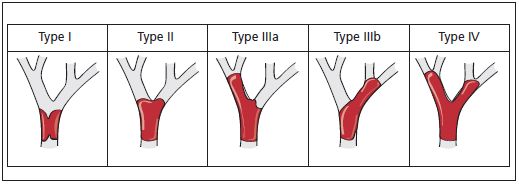
Description
The Bismuth-Corlette classification was proposed in 1975 and revised in 1988. It is divided into four types as shown in the figure.
Type I: Involves the common hepatic duct.
Type II: Involves the common hepatic duct and the confluence of the right and left hepatic ducts (involves the opening of the primary bile duct).
Type IIIa: Involves the common hepatic duct, the confluence of the right and left hepatic ducts, and the right hepatic duct (involves the primary bile duct and the opening of the secondary bile duct on the right side).
Type IIIb: Involves the common hepatic duct, the confluence of the right and left hepatic ducts, and the left hepatic duct (involves the primary bile duct and the opening of the secondary bile duct on the left side).
Type IV: Involves the common hepatic duct, the confluence, and both the right and left hepatic ducts (involves the primary bile duct and the openings of the secondary bile ducts on both sides).
It is generally believed that the following surgical procedures are most reasonable for different types of hilar cholangiocarcinoma: Type I involves local tumor resection; Type II may involve local resection with caudate lobe resection or hepatic lobectomy depending on the specific situation; Type IIIa involves local resection with right hemihepatectomy or central hepatectomy, Type IIIb involves local resection with left hemihepatectomy; Type IV can only choose palliative drainage or liver transplantation.
 Home
Home Back
Back